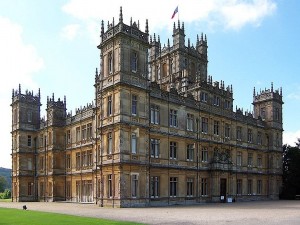Downton Abbey is a television series set on a fictional English estate of the same name. It chronicles the lives of the patrician Crawley family and their servants at the beginning of the twentieth century.
According to Wikipedia, Downton Abbey is a “period drama,” a term used by people who are embarrassed to admit that they are watching a soap opera with corsets. There’s no point in pretending otherwise, as Downton Abbey has all the familiar, soapy elements: betrayal, sex, dead bodies, catty women, unrequited love, etc., etc. This observation isn’t meant to be dismissive. Soap operas aren’t inherently better or worse than any other genre. And by the standards of the genre, Downton Abbey is pretty good. It has decent acting, high production values, and lead writer Julian Fellowes hits just the right notes of the soap genre. I particularly enjoy the mutually destructive, pathological rivalry of the elder Crawley sisters. And no one can deliver a cutting one-liner like Maggie Smith.
After watching the first season, I was reminded of why soap operas are the ultimate achievement of serialized television. The great challenge in serial storytelling is maintaining the interest of the audience for not just hours (as in a film), but for months and even years. Plots must be sustainable over multiple episodes so they can capture viewers for the long-term. The most common technique is to focus on interpersonal – and especially romantic – relationships that viewers can easily connect with. These relationship-centered stories lend themselves to deliberate pacing and slow development over many episodes. There’s the meet-cute moment, like when Matthew Crawley first encounters the lovely Mary, the gradual build-up of the relationship spread out over several episodes, the unrequited sexual tension, and finally the big, romantic kiss during sweeps. But romance is only part of the appeal, and the most successful soaps mix romantic plots with storylines involving betrayal, revenge, or other conflicts. It’s also helpful to have various sub-plots to ensure that the audience does not become bored with any one storyline. Like most soaps, Downton Abbey has a large ensemble cast, so when viewers become bored with Matthew and Mary they can enjoy the scheming Thomas or the rivalry between the Dowager Countess and Matthew’s mother.
The soap opera formula is so effective that even series that are not technically soaps will often adopt soapy sub-plots. More often than not, this means an unrequited romance between two of the main characters (as an example, see X-Files, or Bones, or House, or any drama from the last twenty years). And as entertainment conglomerates have shifted from standalone stories to long-term franchises, the soap opera formula has spread to other media. Every new story has a huge cast and a plot extended across multiple novels, movies, comics, or video games. The soap opera is so mainstream its basic features are taken for granted.
But because the soap opera is so ubiquitous, it’s hard to do anything particularly innovative with the formula. Downton Abbey distinguishes itself from the pack in two ways: setting and social commentary. A pre-WWI English estate is a relatively unusual setting (especially for American audiences), and the series is overflowing with nostalgia for a bygone era of fox hunts and Victorian fashion. The social commentary, on the other hand, focuses on class relations and the role of women in a pre-feminist society. At least in the first season, the treatment of these issues is rather cursory and superficial. The writers want to show the gradual transformation of British society, so there are sub-plots where the youngest Crawley daughter flirts with women’s suffrage and helps a maid find a more respectable job as a secretary. But the series never addresses the roots of social inequality, because to do so the writers would have to acknowledge that the Crawleys are spoiled oafs who’ve coasted through life thanks to their undeserved wealth. So the appeal of the setting – and its adoration of noble privilege – clashes with the attempt to say something meaningful about social change in the twentieth century. At least the social commentary provides a veneer of seriousness that most soaps lack (it’s not just a TV series but a “Masterpiece Classic,” according to PBS).
If Downton Abbey never quite rises above passably entertaining, the blame is mostly due to the lackluster writing rather than the conventions of the soap opera. The soap opera formula is simplistic, but that very simplicity means it can be easily merged with other genres and adapted to the interests of the writer. As an example, The Sopranos possessed many of the typical features of the soap opera (extended plots and sub-plots, large ensemble, an emphasis on relationships), and it successfully combined these features with intelligent social/psychological commentary. If I were to arbitrarily rank Downton Abbey, I’d place it below the best of HBO, but well above the cookie-cutter soaps on network TV. It’s probably on par with Mad Men, another series where nostalgia and social commentary collide.

